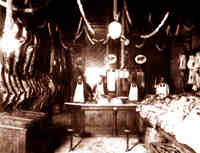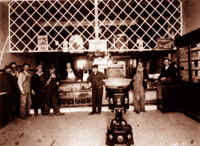|
 |
Farmer City History Cont'd
| The original town of Mount Pleasant was divided into fourteen blocks of twelve lots each and four partial lots, in the center of which was a public square after the manner of old southern towns. This square was a "cut-out" square, as were those in Clinton, Leroy, and several towns in the area, in contrast to the "square" squares in Bloomington and Springfield. Nathan Clearwater erected the first house on the town site and the first store was built by William N. McFall in the autumn of 1837.
John and Mary Smith kept the first hotel. In 1839 the first voting precinct was laid off and Richard D. Webb, John Danner and Dennis Hurley served as judges of the election. William B. McFall was elected Justice of the Peace and Thomas Blalach was constable. Twenty-four votes were cast. |
| In that same year, the first mail was brought into Mt. Pleasant. The mail route was established reaching from Danville to Bloomington. It touched Sidney, Urbana, Middletown (Mahomet), Mt. Pleasant, and Leroy. But there could be no Mt. Pleasant Post Office on that star route, for there was already a Mt. Pleasant in Illinois. Accordingly, the name of Santa Anna was proposed and accepted. Therefore, a family living in Mt. Pleasant was reached by Uncle Sam's mail route at Santa Anna. The name of Farmer City was still far into the future. Mail was delivered once a week at John Smith's establishment, thereby giving him the distinction of being the first postmaster. |

Elmer Krepps Meat Market, 1900's |
| It is interesting to note that a lone figure, reportedly, used to ride horseback in the early 1850's into the tiny hamlet of Mt. Pleasant, a lawyer riding the circuit of the old Eighth Judicial District. His court practice took him through old Mt. Pleasant to various county seats: Clinton, Bloomington, Monticello, Urbana and Danville. William W. Murphy, a lad living with his uncle, John Smith, at the old hotel, blacked the man's boots as he stayed overnight with landlord Smith. Today we call the memory of this pioneer lawyer sacred in the pages of American history. Uneducated, but truly self-educated, he penned immortal English, such as none of of us can write today -- The First Inaugural, the Second Inaugural, the Gettysburg Address. the letter to Mrs. Bixby. His name, Abraham Lincoln, is enshrined in the everlasting annals of Time. |

Hurley's Meat Market and Old Fish Bowl, 1939 |
The Weedman and McCord Addition was platted in 1870 to "carry the town to the railroads." Many other towns had grown up around, or moved to the railroads when they arrived. But Mt. Pleasant was here, with the center of activity located "at the foot of Main Street" when the railroads came curving northward and northwestward, almost missing the town. By the early 1870's the Indiana-Bloomington-Western Railroad (the old I.B.& W.) and the Gilman-Clinton-Springfield Railroad provided freight and passenger service all directions from the town, thus establishing it as a farm center in DeWitt County. This led to more growth in business. The 1870 census for Santa Anna Township was 1276 people, with the population in Mt. Pleasant at 537. |
| Numerous other additions were platted as the town continued to prosper and grow in the 1870's and 1880's. These included the Weedman and Blackford, Huddleston, Herrick, Cumming, Watson, Moore, Norris, McMurry, Bean, Keenan, and Sangster Oak Grove Additions, the latter including Washington Street, known as "Silk Stocking Row" in reference to the doctors, bankers and grain dealers who built homes there.
During this time, the citizens of Mt. Pleasant. weary of having two names, one for the town, and another one for the Post Office, decided they needed to change the situation. In 1869, a group met at the Stone Hotel, situated on the west end of the lot where the Rex Jackson building stood for many years. The purpose of the meeting was to choose a new name for the growing city. Quite a number of names were suggested. but none seemed to have the approval of the majority. It was later reported that someone finally spoke up and said,'The majority of the people here tonight are farmers and the room is heated with burning corn (as corn was cheaper than coal), fuel which is produced by the farmers. Mr. Chairman, I move that we change the name of Mt. Pleasant to Farmer City." The motion was offered, seconded and carried.
It was Jacob Swigart, a member of the State Legislature, who introduced a bill into the Assembly in 1869 approving the change of the town name to "Farmer City". He reportedly rode back to his home and walked in and announced, "There is no longer a Mt. Pleasant in DeWitt County."
And so it was. |
| Four major events affected the future of Farmer City before 1900. The arrival of the railroads allowed the town to grow and prosper. The Civil War took its toll on Farmer City residents, disrupting family life. Many men from Farmer City fought in the war and a number of them did not return. After the war was over, and the men who survived came home, the growth of the community greatly expanded. The fire of 1879 destroyed most of the business district, but merchants quickly rebuilt, keeping the business district downtown, rather than moving it closer to the railroads as many other towns had done. The fire of 1894, which also destroyed many businesses, resulted in the city fathers writing fire ordinances, and other ordinances to improve community welfare, setting the stage for modern city life and development as Farmer City entered the 1900's. |

Kendall Theatre, 1943 |
| Wooden sidewalks which had been built in 1869 and 1870 slowly disappeared as new concrete walks were put in in the early 1900's. The new sidewalks proved so satisfactory that on September 7, 1907, the city council passed a resolution that all future sidewalks built in the city limits were to be concrete.
The two-story brick City Hall building was erected in 1904. In May 1912, the city fathers decided to brick pave portions of Main Street, the public square, and parts of Plum and Market Streets. In 1924, and in future years, more streets were paved.
The city Superintendent of Streets directed the posting of street names and house numbers throughout the city in 1921. The original public water supply was installed in 1894 for the City of Farmer City, with several wells being drilled over the years. In the early 1920's the water tower was built. Before 1950, kerosene lamps were used to illuminate the business district and street corners. However, in that year, Main Street was widened and mercury vapor lighting was installed. On September 4, 1950, Mayor Hester made a dedication address and turned on the new street lights. The illumination of our Main Street became the envy of our neighboring towns. From the dust, mud, and kerosene street lamps, a modern business district had developed, thanks to the dedicated people who had voted for, and worked for civic improvements.
City gas became available to residents in 1956 when the Northern Illinois Gas Company began providing the natural gas for heating and other utilities.
Under the supervision of Dean Schmitz, a sewage disposal plant was put into operation on July 1. 1958.
Interstate 74 was completed in the early 1970's, bringing the new four-lane highway through the northern portion of the city.
In the early 1980's, cable television was offered.
Which business would be the oldest continuous one in Farmer City? That business was started January 9, 1840. The product for this business was brought to Mt. Pleasant once a week by horseback by James McKillop. Later in the 1840's this product was carried by two-horse hack, semi-weekly. By 1869 Mt. Pleasant had changed its name to Farmer City and the Santa Anna Post Office in Mt. Pleasant also changed its name to the Farmer City Post Office. The Post Office was named Santa Anna in 1840 because there was already a Mt. Pleasant Post Office in Illinois. The mail might he considered a product in the early days because the receiver rather than the sender paid the fee. The mode of mail delivery switched to the railroads by 1871 and was delivered daily. Delivered many years by railroad, the mail has been brought to Farmer City by highway truck in recent times.
During the first fifty years, Farmer City had several postmasters since the job was not full time and their appointment was controlled by politics. Sometime after 1900 the postal service came under civil service and the postmasters stayed for much longer periods of times.
The post office has never owned a permanent building since 1840 but has always rented or allowed the postmasters to use their home or place of business. Some people living today will remember when the post office was in the building now housing the Farmer City Public Library from 1916 to 1927. In 1927 the post office moved to the building that is now occupied by the law firm of O. A. Peithman and William Peithman. Finally in June of 1967 the present building across from the library was opened.
Rural delivery was started in 1902 and city delivery was inaugurated in 1921. In the 1920's carriers were visiting the town homes twice daily. Some of the early rural carriers were Phil Halloway, Rucker Weedman, Clarence Lowry, Otis Nichols, and Tom O'Mallie. More interesting information about the postal history of Farmer City can he obtained by reading newspaper articles found in the Farmer City Public Library. |
|

